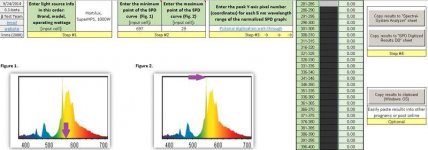Beta Test Team
Member
Most growers wont' spend the needed money on a quantum sensor, so a good lux meter is a really good option for most people. (We use quantum sensors, not lux meters.)
That quantum sensor you cited is not worth the price. You want a better filtered sensor. Like LI-COR (or Kipp & Zonen), which is about $400 for the sensor and about $600 for the light sensor, so that's about $1,000.
The Apgoee quantum sensors are not very accurate, they cut off a lot of the red range in PAR so you don't get a very accurate PPF. If a grower is willing to spend $400 to get an Apogee, they should cough up an extra $600 and get the LI-COR, or get a good lux meter (~$200).
It's better to use a good lux meter (because they have really good filters), and convert that lux to PPF using our spreadsheet (once the users' SPD is analyzed by the spreadsheet), to find PPF. Or, just a good quantum sensor, like from LI-COR or Kipp & Zonen, notApgoee.
Dr. Bugbee's company Apogee is good for some things, but not quantum sensors (due to the less than ideal filters they use).
That quantum sensor you cited is not worth the price. You want a better filtered sensor. Like LI-COR (or Kipp & Zonen), which is about $400 for the sensor and about $600 for the light sensor, so that's about $1,000.
The Apgoee quantum sensors are not very accurate, they cut off a lot of the red range in PAR so you don't get a very accurate PPF. If a grower is willing to spend $400 to get an Apogee, they should cough up an extra $600 and get the LI-COR, or get a good lux meter (~$200).
It's better to use a good lux meter (because they have really good filters), and convert that lux to PPF using our spreadsheet (once the users' SPD is analyzed by the spreadsheet), to find PPF. Or, just a good quantum sensor, like from LI-COR or Kipp & Zonen, notApgoee.
Dr. Bugbee's company Apogee is good for some things, but not quantum sensors (due to the less than ideal filters they use).
Last edited:





